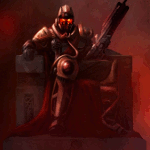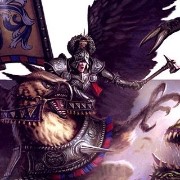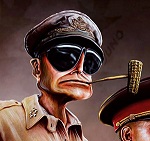|
I thought the confederate's primary system of supply for anything they couldn't manufacture was just to steal it from the Union.  Certainly a lot of my books mention confederate soldiers wandering off to look for fresh food. And shoes. Shoes were a never ending problem for the Confederacy. Cyrano4747 posted:other gun Maybe you should lay out how a percussion based primer system differs from a flintlock system? Jamwad Hilder posted:I always think it's fascinating that the American Civil War started out as a war at least somewhat reminiscent of the Napoleonic wars, but four years later you have armies using trains and telegraphs for rapid movement and communication, ironclad battleships, submarine warfare, trench warfare, repeating rifles, etc. I've read an anecdote that mentions indirect offshore artillery fire and a spotter guiding and correcting the shells as they landed, I can't remember all the details though.
|
|
|
|

|
| # ? May 12, 2024 09:10 |
|
My wife and I were having this conversation last night - she grew up in the South and got most of her Civil War education from biased sources, whereas I've never really had any exposure to the Civil War. We were trying to figure out what motivated individuals to join up with the local Confederate armies. Was it an ideological thing to defend the state's right to own slaves? Was it simply that all of their friends were doing it (similar to, I suppose, WW1?)? Or was it something more basic like "They were poor and white and conscription happened."?
|
|
|
|
Klaus88 posted:I've read an anecdote that mentions indirect offshore artillery fire and a spotter guiding and correcting the shells as they This probably isn't the first example of indirect fire but it gets quoted as such fairly often. tldr: a CSA gunner did some math and figured out how to drop shells with some accuracy on a BLOS target SquadronROE posted:My wife and I were having this conversation last night - she grew up in the South and got most of her Civil War education from biased sources, whereas I've never really had any exposure to the Civil War. A very, very small percentage of the antebellum south actually owned slaves or came from families that owned slaves. Soldiers, especially early on, were more likely to own slaves than were the general population, but it was probably still between only a quarter and a third of the Army had a direct involvement with slavery either through direct ownership, through their job (overseers, traders and the like), or through their families. Like the north, the vast majority of the southern armies were made up of yeoman farmers. In any case, not many of them would have said "to defend slavery" was their reason for joining. The most common political reason you'd have seen was "because the yankees are invading" or "to defend my state" or something like that; the real reason for most was because it was an adventure, because it was money, or because their friends/family/neighbors did. bewbies fucked around with this message at 19:25 on Jun 25, 2015 |
|
|
SquadronROE posted:My wife and I were having this conversation last night - she grew up in the South and got most of her Civil War education from biased sources, whereas I've never really had any exposure to the Civil War. For some people it was as simple as are country is at war.
|
|
|
|
|
And the Confederacy practiced conscription. Are county is gonna make you fight or else.
|
|
|
|
It really varies, it's really hard to say what the motivations of confederate soldiers were, but foremost to me was the protection of their home state. There were invaders and they needed to be repelled. That does tie in with state's rights to some extent, but it wasn't really because the common soldiers wanted to defend the institution of slavery. Don't get me wrong, the civil war was primarily focused on slavery (and especially its expansion), but the common soldier in the CSA didn't really have its protection as his priority. Edit: Conscription did start, but not immediately, at the start of the war most soldiers were volunteers. Edit x2: The first conscription act in the CSA was only put into law in April 1862 Tekopo fucked around with this message at 19:27 on Jun 25, 2015 |
|
|
|
Tekopo posted:It really varies, it's really hard to say what the motivations of confederate soldiers were, but foremost to me was the protection of their home state. There were invaders and they needed to be repelled. That does tie in with state's rights to some extent, but it wasn't really because the common soldiers wanted to defend the institution of slavery. Don't get me wrong, the civil war was primarily focused on slavery (and especially its expansion), but the common soldier in the CSA didn't really have its protection as his priority. Out of curiosity, what are you basing this on? Are there good sources that are unbiased accounts of why people joined up on the Union/Southern sides?
|
|
|
|
SquadronROE posted:Out of curiosity, what are you basing this on? Are there good sources that are unbiased accounts of why people joined up on the Union/Southern sides?
|
|
|
|
SquadronROE posted:Out of curiosity, what are you basing this on? Are there good sources that are unbiased accounts of why people joined up on the Union/Southern sides? Glatthaar is kind of the de facto expert on demographics of the southern armies, his studies are pretty excellent and very well sourced. That's where I'm drawing my info from.
|
|
|
|
SquadronROE posted:Out of curiosity, what are you basing this on? Are there good sources that are unbiased accounts of why people joined up on the Union/Southern sides? Prior to the Civil War, most people, particularly Southerners, felt they were citizens of their state first, and of the United States second. Most signed up to defend their state from the Northern invaders. As Shelby Foote put it, the Civil War resulted in a change of grammar. Previously, the wording was "The United States are..." while afterward it was "The United States is...". The basic concept of the nation was changed.
|
|
|
Klaus88 posted:Maybe you should lay out how a percussion based primer system differs from a flintlock system? I think this is a good opportunity for a big post detailing the history of firearm mechanisms. The very first guns didn't have any form of action at all. The user simply held a length of burning something to the touch hole, detonating the gunpowder. This made it virtually impossible to aim, as you can see by the woman's awkward stance, and many early "gonnes" were mounted on tripods; handheld firearms are descended from cannons, and the first guns were literally miniaturized artillery pieces. The first "lock" (a method of automatically detonating the gunpowder with a mechanism) was the matchlock, appearing around the 1450s. This is simply a holder for the length of matchcord, placed on a spring-loaded hinge with the other end protruding out the bottom of the stock. You pull the bottom end backwards, and it levers the match down into a pan full of gunpowder. This gunpowder flares up, and the tiny explosion of flame goes through the touch hole into the gunpowder sitting at the back (the breech end) of the barrel. Most matchlocks were simply hinged levers with a spring to let the trigger and serpentine (the match holder) rotate back when you let your finger off the trigger; there were also snapping matchlocks that had the serpentine fitted with a proper sear and spring mechanism, which allowed the match to rapidly snap into the pan, but these tended to extinguish the match on impact and were mostly used as target guns. Matchlocks have many obvious drawbacks: the match has a distinctive smell and is visible glowing at night, it's useless in the rain, and the match needs to be kept lit to be reliable in battle (it's estimated that an English soldier on guard duty could burn up a mile of match in a year of just walking around with his gun at the ready). And of course, you've got flaming matchcord flopping around gunpowder. A more elegant, fireless solution was needed. Starting in 1500, that was the wheellock. This was a complex mechanism, but the basic firing principle is iron pyrites sparking on steel. The "dog" is a set of jaws holding a piece of iron pyrites, which is placed over a notched steel wheel. The wheel is wound up by inserting a square key in and turning it, and pulling the trigger simultaneously opens a cover on the pan, spins the wheel, and lowers the iron pyrites onto the wheel. This creates a shower of sparks that detonates the powder. The biggest advantage is that it removes the match from the equation, and its flaws (smell/sight, constantly consumable resource, danger around gunpowder, and lack of weatherproofing) were all gone with it. It also led directly to the first gun control laws after it was realized (and put into effect) that these guns could be kept hidden under clothing safely and quickly drawn and fired for assassination. The downside, as you can see by looking at the mechanism, is that it has watchmaker levels of complexity and was quite expensive. They were issued to the guys who worked around gunpowder and cavalry, but their expense kept the matchlock working fine. The wheellock did create the idea of creating sparks to detonate gunpowder, though, and this led to a new attempt to harness it around the 1550s: the snaphance. Also called various things like "snaphence" or "snaphaunce" depending on language and dialect. The snaphance has a set of jaws called a cock (since it looks kinda like a rooster's beak) that holds a piece of flint. There's a piece of steel, plus a pan cover that keeps the gunpowder in the pan clear of the rain and makes it more reliable than a matchlock in the rain (much like a wheellock). The cock is held back by a spring, with the trigger tripping a sear that releases it. The big, swinging cock scrapes the flint across the face of the steel (while a mechanism opens the pan cover), showering sparks into the pan like a wheellock. It's much less complex than a wheellock. It still wasn't perfect, though. A little cleverness let them invent the flintlock in the early 17th century. It's mostly the same as the snaphance, but simplified: the separate steel and mechanically-opened pan cover are replaced with an L-shaped piece of steel called the frizzen. The frizzen is held shut by a spring and covers the pan while also providing a piece of steel for the flint to scrape down: the flint pushes the hinged frizzen up and off the pan as it scrapes along its surface. The flintlock's simplicity and reliability immediately made it the premier firearm lock in the world, and it superseded all other locks in every country it spread to (though not every country did and it wasn't immediate; some European countries kept matchlocks until the 1720s and Tibetan nomads are still using matchlocks today for hunting and occasionally guerrilla warfare in the 20th century). What finally got rid of the flintlock in the late 19th century was the caplock. Experiments in chemistry during the early and mid 19th century eventually discovered that fulminate of mercury is a shock-sensitive explosive. There had been problems with flintlocks not reliably firing, and even when it went off there would be a delay of either an imperceptible fraction of a second to half a second between pulling the trigger and the gun firing. Alexander John Forsyth created a system in which tiny copper caps full of mercury fulminate would be placed over a "nipple", a hollow tube leading into the breech. The cock was replaced with a simple hammer that whacked the cap, detonating it and creating a tiny explosion that flashed through the hollow nipple into the gunpowder in the barrel. There were several major advantages to this: it 100% waterproofed the gun (there was no longer a chance of moisture getting into gunpowder in the pan, as the gunpowder was no longer there) and the percussion cap instantaneously exploded and fired the gun. Then again, you had to have the dexterity to put the tiny little cap on the nipple during the heat of battle (leading to some automatic cappers, like on the Sharps carbine used by cavalry in the Civil War; you just thumb a paper cartridge into the breech and the gun flips a cap on from an internal magazine as you pull the trigger). The caplock actually had a very short reign on the battlefield, as its invention very rapidly led to the development of reliable cartridges. Repeating and fast-loaded firearms in the mid and early 19th century often used paper cartridges, like the early Colt revolvers (Dragoon, Army, Navy, etc.) and the Sharps carbine. These were nitrated paper tubes filled with gunpowder and with a bullet glued at the end, which would be loaded into the chamber and burn up on firing. These were imperfect, often leaving soot and unburnt paper that had to be cleaned out. Before these were made, "cartridge" referred to a tube of paper with enough powder for one shot and a bullet. You would tear open one end with your teeth, pour a little powder into the priming pan, and then pour the rest of the powder down the barrel and shove the paper and bullet down after it. The paper cartridges as used in revolvers and breech-loaded rifles weren't a very good option for things like magazine loading, and they didn't really seal the breech. What was needed was a metal tube that could hold all the components. The Swiss gunsmith Jean Samuel Pauly created a variant of the paper cartridge with a copper base that was filled with potassium chlorate primer. This created a totally self-contained cartridge that would disintegrate upon firing. The concept was expanded upon until rimfire cartridges could be made. These were brass tubes filled with gunpowder, and the rim at the base is filled with priming compound. The neck is crimped around a lead bullet (this pictured cartridge is .22 Short, which dates back to I think the 1860s with the Smith & Wesson No. 1 revolver and is still in use today). Brass is a very good cartridge material: it's an excellent heat conductor (taking a lot of the heat of firing away with it when it's removed from the gun), it expands upon firing to seal the breech and then contracts again to let it be easily extracted, and it's ductile enough to be reloaded. In rimfire guns, there's now a firing pin that the hammer hits or is attached directly to the hammer; the pin crushes the rim, creating a shock that detonates the primer. There were a few efforts to make pinfire cartridges (which incorporate the firing pin into the rim), but these aren't a very good cartridge because they're basically rimfires that have to be inserted one way into the chamber. Rimfires, of course, have their problems. While cheap to make in large lots, they require large scale mass production machinery that has a high initial cost. They're not easily reloadable by people without industrial machinery, and the need to have a crushable rim naturally restricts the thickness of the case and in turn restricts the potential load of gunpowder. The way to get around this is a centerfire cartridge. The centerfire has a primer (basically a slight modification to a 19th century percussion cap) set into the center of a cartridge's base. Because only this cap is getting crushed and detonated, the case can be made as thick as you want. This allows for cartridges to be loaded with obscene amounts of powder, letting us use things like magnum hunting rifles and 20mm autocannons that can blow holes bigger than your head in a brick wall. A variant of the centerfire cartridge is the shotgun shell. It's a centerfire like other cartridges, but instead of a brass case (except for some specialty shells) it has a plastic or paper hull filled with powder and the particular shot load (along with other stuff like a plastic cup to hold all the shot together in the barrel and wadding between the cup and the powder). Shotshells can be loaded with virtually anything that fits, leading to some interesting ideas: https://www.youtube.com/watch?v=LzfzHg7Ilx0 https://www.youtube.com/watch?v=Ef6bF4tbtO4 https://www.youtube.com/watch?v=dAB48S8wAR8 chitoryu12 fucked around with this message at 20:42 on Jun 25, 2015 |
|
|
|
|
edit: ^^^^^ jesus that's what I get for getting a glass of water while writing a post.Klaus88 posted:Maybe you should lay out how a percussion based primer system differs from a flintlock system? The only real difference is where the spark comes from. On a flintlock system the flint strikes a piece of metal and makes sparks which ignite loose powder sitting in a pan on the side of the gun. That powder cooks off and sets off the main charge, which is connected to the pan by a thin hole in the barrel. In a percussion cap system there is a small nipple (yes, that's what it's called) that protrudes from a flat bit on the side of the barrel. That nipple is hollow and connects to the main charge through a small hole in the barrel, same as a flintlock. A percussion cap is placed on the nipple. This cap is basically a copper cup filled with pressure sensitive explosive. The hammer comes down on that, and that charge ignites the powder in the main part of the gun. The two systems are related enough that it is entirely possible to convert a flintlock to a percussion cap system. The main advantage is that you don't have to deal with loose powder in the pan which makes it much more reliable in damp conditions and much easier to carry a loaded gun. The ignition is also a bit more reliable and you don't have to worry about losing or breaking a flint. The other thing to note is that a percussion cap is the first step towards cartridge based ammunition. The primer found in the base of modern ammunition is essentially identical to a percussion cap. The firing pin that strikes the primer performs the same function as the hammer on a percussion cap system.
|
|
|
|
I actually have a picture handy of a flintlock that was converted to percussion. You can see how a good part of the flintlock mechanism is still there, just frozen in place with the nipple put in and a hammer replacing the cock. Nipples and cocks are a major part of firearms history.
|
|
|
|
|
Hopefully this thread should dig this short film, made by Veterans for Peace UK: http://battlefieldcasualties.co.uk/ Hell hath no cynicism like a squaddie scorned.
|
|
|
|
SquadronROE posted:My wife and I were having this conversation last night - she grew up in the South and got most of her Civil War education from biased sources, whereas I've never really had any exposure to the Civil War. It depends heavily on the area. Where I grew up in Texas, for example, most of the German/Czech immigrants that populated the area draft dodged the war in various ways. One notable massacre happened of Germans trying to flee to Mexico to avoid conscription. Texas is unusual in this case, though, because it was far outside the main theaters of the war, so the average citizen didn't really have the "Yankees are invading" justification that someone in, say, Georgia might have. I've also heard of examples of Texans fighting on both sides of the war, but I've only seen blurbs about it on Wikipedia.
|
|
|
|
Trin Tragula posted:Hopefully this thread should dig this short film, made by Veterans for Peace UK: I don't even know how to feel after watching that.
|
|
|
|
I believe this was mentioned here before, but is the assertion that during the American Civil War, most common soldiers were generally politically aware of why the war was being fought, especially in comparison to other wars at the time? I.e., most Union soldiers understood that they were fighting to end slavery and most Confederate soldiers understood they were fighting to preserve it? Also, what was the rate of defection and desertion in the Confederate army in comparison to the Union? Were they ever politically motivated?
|
|
|
|
Glory, glory, hallelujah! Glory, glory, hallelujah! Glory, glory, hallelujah! Our God is marching on. In the beauty of the lilies Christ was born across the sea, With a glory in His bosom that transfigures you and me. As He died to make men holy, let us die to make men free, While God is marching on.
|
|
|
|
bewbies posted:Glatthaar is kind of the de facto expert on demographics of the southern armies, his studies are pretty excellent and very well sourced. That's where I'm drawing my info from. It is worth noting that the army of 1861 that first joined up was far more heavily involved with slavery. In that army, one in ten owned slaves personally, one in four lived in a house with family who owned slaves, another one in ten lived in households with non-family slaveholders. That's about half that army that lived in a slaveholding house, and many others were involved directly with the economics of slavery. Also Glatthaar is a great professor and I'd sell a kidney to have been less overloaded while taking his class. It was basically a social history of the US military and it was all kinds of interesting. SpaceViking posted:It depends heavily on the area. Where I grew up in Texas, for example, most of the German/Czech immigrants that populated the area draft dodged the war in various ways. One notable massacre happened of Germans trying to flee to Mexico to avoid conscription. Texas is unusual in this case, though, because it was far outside the main theaters of the war, so the average citizen didn't really have the "Yankees are invading" justification that someone in, say, Georgia might have. There was also strong opposition to secession in East Tennessee, which got them voter suppression until secession and then military occupation (are rights). Areas without much slavery weren't keen on secession at all.
|
|
|
Jobbo_Fett posted:
 Yeah, pretty much.
|
|
|
|
|
chitoryu12 posted:Nipples and cocks are a major part of firearms history. Hellllo next thread title! For a related topic; this covered the firing mechanism, but how did the gunpowder change in relation to these? People were talking about how the fouling from earlier gunpowders used were a big factor in performance, I know, but I was wondering how well improvements in gunpowder lined up with when improvements in firing system came in? For example, did cartridges get adopted because gunpowder got good enough to use them around the same time, did one come before the other, or what?
|
|
|
|
MadDogMike posted:Hellllo next thread title! For a related topic; this covered the firing mechanism, but how did the gunpowder change in relation to these? People were talking about how the fouling from earlier gunpowders used were a big factor in performance, I know, but I was wondering how well improvements in gunpowder lined up with when improvements in firing system came in? For example, did cartridges get adopted because gunpowder got good enough to use them around the same time, did one come before the other, or what?
|
|
|
|
As HEY GAL says, there were just basic changes and experiments with the proportions of ingredients and the milling methods. Nothing too substantial changed until the advent of the game-changing Smokeless powder.
|
|
|
|
|
Was the advent of paper cartridges just based on the availability and cost of paper?Fangz posted:Glory, glory, hallelujah! Yes we'll rally round the flag, boys, we'll rally once again, Shouting the battle cry of freedom, We will rally from the hillside, we'll gather from the plain, Shouting the battle cry of freedom! The Union forever! Hurrah, boys, hurrah! Down with the traitors, up with the stars; While we rally round the flag, boys, we rally once again, Shouting the battle cry of freedom! We are springing to the call of our brothers gone before, Shouting the battle cry of freedom! And we'll fill our vacant ranks with a million freemen more, Shouting the battle cry of freedom! We will welcome to our numbers the loyal, true and brave, Shouting the battle cry of freedom! And although they may be poor, not a man shall be a slave, Shouting the battle cry of freedom! So we're springing to the call from the East and from the West, Shouting the battle cry of Freedom; And we'll hurl the rebel crew from the land we love best, Shouting the battle cry of Freedom. PittTheElder fucked around with this message at 23:43 on Jun 25, 2015 |
|
|
|
Let's just post the best Civil War song and get it out of the way https://www.youtube.com/watch?v=lUSJA-vtg_s
|
|
|
|
ALL-PRO SEXMAN posted:Here's a bit of trivia that I love because I'm really, really immature: the French developed a standardized system of artillery guns that incorporated a successful mechanism for sealing the breeches of breech-loading field guns (to prevent gas and burning gunpowder escaping through the wrong end of the gun) in the late 19th century and named it after the mechanism's developer. It was called the Système de Bange. T___A fucked around with this message at 00:58 on Jun 26, 2015 |
|
|
|
https://www.full30.com/video/82efb579fd3c93d177205966ef3d3c9d The guy from Forgotten Weapons did a thing about exploding bullets from WW2.
|
|
|
|
StashAugustine posted:Let's just post the best Civil War song and get it out of the way I love I goes to fight mit Sigel but this is the best one. https://www.youtube.com/watch?v=A5ra9cXx1-o Thank god for it, Dixie is a really good tune I'd hate to see ruined.
|
|
|
|
Negligent posted:The First Crusade put European armies in the (now) Middle East. What kind of weapons and armour were the respective sides using? Not sure about the Crusaders, but the Arabs and Turks in the middle east were pretty different in arms and organizations, that quote about "muslim" bows is pretty much garbage though, its either Arab or Turkish bows, and the latter was of pretty good quality in general. The Arabs during the crusades didn't really have much quality arms or armor, most of their armaments were imported, the local industry of weapons or armor was middling at best too. To my understanding Arabs were pretty similar in organization to the crusaders, not much use of horse archers, they also lacked heavy cavalry, The Kurds/Arabs were fairly similar if you want to include Saladin/the Ayyubids. Many favored lighter armor, for example most of the levies had a middle eastern version of the gambeson, its basically cloth/padded light armor, sometimes included leather, the richer types could afford to have several materials (silk is mentioned) woven into it, as well as the thickness of the cotton. Chainmail was in use, but my understanding is that the Arabs were surprised at the "Franks" wearing two layers of chainmail, so its probably commonly believed that chainmail was lighter (my source for that last part comes from some anecdote by Usama bin Munqidh, so ymmv  ). I have very little information on the types of weapons used, spears, javelins, crossbows, bows, glaives and maces were common, single edged straight swords too. ). I have very little information on the types of weapons used, spears, javelins, crossbows, bows, glaives and maces were common, single edged straight swords too.The makeup of these armies included local forces that were levied mostly either from Egypt or Syria, volunteers also came from a wider area (Kurds), religion was a hell of a thing though, for example alot of the Fatimid levies were still copts at this point too or at least some weird syncretic sort of christian/muslim (around 1085 when the first crusade kicked off). There were also the Mamelukes, basically a term that evolved from the Ghulam, but they weren't really an elite force or anything, the term means "formerly owned" which is vague, because it could either mean they are slaves or were emancipated to be free men, they were fielded as cavalry mostly, usually the point of a mameluke was to have a foreigner slave soldier to guard a sultan or other figure of power from court intrigue. The use of African slaves was still a thing from peninsular Arabs, the Sudanese were mentioned commonly as well but mostly in Fatimid service, at that point though court intrigue was at a high moment in the middle east, so Saladin evicted most of them from their posts after the Fatimid Sultan croaked. Siege weapons were apparently in use, but not much, and not wildly different from the other forces, ballistas, and catapults were used, nothing too sophisticated, Saladin also tore down the walls of Jerusalem when that city was retaken, so i assume siege works weren't very complex and probably not something commanders looked into very much, no walls meant it was easy to retake the city the next time someone invades it. Also during this period ships didn't evolve much, the basic 12th century warship in employ by Egypt was called a Shalandi, this didn't evolve much from the previous iterations of that vessel which was in use as early as the 7th century, it functioned pretty much like a galley, had better transport capacity compared to European ships and allowed for more siege weapons, and better armor (called "Tabut" or coffin usually to protect archers in the rear). Naptha was in use, something similar to greek fire, or reverse engineered from it. I only recall two naval engagements and i don't remember their names in particular, but both times the Arabs lost, and one where they won, but mostly because the crusaders faced a storm, there was no real effort to maintain a navy by the Muslim dynasties in the region. Alot of the academic research in middle eastern medieval armies were extrapolated though, very little in terms of manuscripts survive in Arabic, alot of it is either from Turkish/Persian manuscripts, or middle eastern church murals, sometimes from palaces as those were also lenient in depicting humans in them.
|
|
|
|
I really enjoyed reading The Crusades Through Arab Eyes. It gave a good overview of the political and military movements in the Levant during the Crusades.
|
|
|
|
Raskolnikov38 posted:I love I goes to fight mit Sigel but this is the best one. 
|
|
|
|
Raskolnikov38 posted:I love I goes to fight mit Sigel but this is the best one. drat thats a fine version
|
|
|
Raskolnikov38 posted:I love I goes to fight mit Sigel but this is the best one. There's a mod for Mount & Blade: Warband set in the Civil War that uses that song as one of the background tracks (along with stuff ripped from Western movies).
|
|
|
|
|
xthetenth posted:
Seconding. I had him multiple times at North Carolina and he did an excellent job of making clear the faults of the confederacy. But he did so in a way that acknowledged and pointed out areas in which the CSA excelled at. Too often we argue the losing (in this case wrong) side of a conflict were stupid. It's possible to be both wrong on a moral or political issue while remaining incredibly intelligent or at least not brain dead. As for whether U.S troops fought to end slavery as their motivation: eh... Not as much my subject but Gallagher argues that the idea of preserving the Union was a stronger concept for most. As the war dragged on though, anti-slavery sentiment increased for Union troops. And yet, we shouldn't go too far with this without noting how anti slavery and abolitionism are very, very different. Not to mention how social and economic equality were not goals for even many abolitionists. It was one thing to free slaves ( of course enslaved people often freed themselves) and it was quite another matter to accept competing with freedmen for jobs. On a side note I really enjoy W.E.B Du Bois characterization of emancipation as a general strike. It has its problems but it's an interesting concept.
|
|
|
|
President Abraham Lincoln posted:I have always thought `Dixie’ one of the best tunes I have ever heard. Our adversaries over the way attempted to appropriate it, but I insisted yesterday that we fairly captured it. [Applause.] I presented the question to the Attorney General, and he gave it as his legal opinion that it is our lawful prize. [Laughter and applause.]”
|
|
|
|
Marlows posted:On a side note I really enjoy W.E.B Du Bois characterization of emancipation as a general strike. It has its problems but it's an interesting concept. I'm curious if someone could explain this idea in more detail?
|
|
|
|
Rhymenoserous posted:From my understanding Germany never really did the "War economy" thing to the extent that allied nations did. This is a common misconception.
|
|
|
|
Marlows posted:Seconding. I had him multiple times at North Carolina and he did an excellent job of making clear the faults of the confederacy. But he did so in a way that acknowledged and pointed out areas in which the CSA excelled at. Too often we argue the losing (in this case wrong) side of a conflict were stupid. It's possible to be both wrong on a moral or political issue while remaining incredibly intelligent or at least not brain dead. Hah, awesome, someone else with good taste in colleges. He made getting enough classes to fill a history minor's requirements while doing compsci fun and worth it. The coverage of lesser-known stuff like the Mexican-American and Spanish-American wars was great too.
|
|
|
|
Thanks for the big effort post on firing mechanism development, it's something I've been meaning to learn about for awhile.
|
|
|
|

|
| # ? May 12, 2024 09:10 |
|
bewbies posted:A very, very small percentage of the antebellum south actually owned slaves or came from families that owned slaves. Soldiers, especially early on, were more likely to own slaves than were the general population, but it was probably still between only a quarter and a third of the Army had a direct involvement with slavery either through direct ownership, through their job (overseers, traders and the like), or through their families. Like the north, the vast majority of the southern armies were made up of yeoman farmers. In any case, not many of them would have said "to defend slavery" was their reason for joining. The most common political reason you'd have seen was "because the yankees are invading" or "to defend my state" or something like that; the real reason for most was because it was an adventure, because it was money, or because their friends/family/neighbors did. To expand on this, slave-owning planters were a tiny proportion of the population but were by far the wealthiest and most influential class in the antebellum USA, North as well as South. Most people did not own slaves, and most people who did own slaves owned only a handful at most, but the tiny minority of substantial planters owned the majority of slaves. The wealth the Southern elite held in land and people was astronomical, and the economic value of their agricultural enterprises, especially cotton, was enormous. They also dominated the federal government for the first half of the 19th century. Now, if you go down to the state and local level their wealth and influence is hard to imagine. In much of the South, state and local government is basically contiguous with planter interests, no daylight between them. In marginal and less-desirable areas like the Appalachian Mountains, which did not support plantation agriculture, there is a substantial backlash. Andrew Johnson made a career out of it before the war, and of course during the war those areas split--or tried to split--from the Confederacy. One way of reading the run-up to the Civil War is that the antebellum period saw a power play by the planter class to maintain, solidify, and extend their control of the federal government. Until the 1850s they were really going from strength to strength. When the tide began to turn against them, they tried to break away the parts of the country over which they had complete control and form an independent nation, which they would rule without interference from grubby Yankee merchants, financiers, and religious nuts. The rank-and-file Confederate soldier didn't own slaves, but he lived in a political and social system that was absolutely dominated by large slaveholders. The actual leadership of the Confederacy was deeply implicated in slavery and motivated almost entirely by the desire to preserve and expand the slave system, which was the objective of initiating the war in the first place. The bulk of the population was basically in a position where their patriotism--loyalty to their state and locality--was bound up with that project. This was in part the outcome of a deliberate plan--slavery apologetics were an entire genre of antebellum political literature. One also shouldn't deny that whereas nearly all white Americans at the time were white supremacists, it was a much more present, important, and integral part of Southern culture than Northern. It could not fail to be, considering that it was Southerners who had actual regular contact with African Americans and functioned as the vanguard and enforcement arm of the white supremacist system.
|
|
|





























 Yes, it's like a lava lamp.
Yes, it's like a lava lamp.













